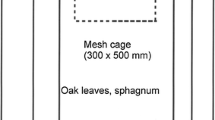Abstract
Transmission of Yersinia pestis to the long-tailed suslik (Citellus undulatus) by fleas (Citellophilus tesquorum) in the Tuva natural plague focus in different seasons (spring, summer, and autumn) was studied experimentally. Between feeding periods, insects were kept in an artificial nest under temperature and humidity closely corresponding to seasonal ones. The character of the agent transmission was estimated according to the fraction of fleas with the agent in the aggregated state (bacterial lumps, partial blocks of proventriculus), the fraction of blocked individuals, and the fraction of infected susliks and of those with the generalized form of infection. Seasonal dynamics of epizootic process of the Y. pestis transmission corresponded to the results obtained in the epizootic examination of the Tuva natural plague focus and reflected the dynamics of the epizootic process (increase-peak-decline). The activity of the formation of a proventriculus block in C. t. altaicus, the infection ability of the fleas, and the sensitivity of long-tailed Siberian susliks to Y. pestis were the highest in mid-summer (July-first ten days of August), during the period of epizooty activation in the focus. The maximal number of C. t. altaicus with the plague agent at the aggregated state was observed in the cold period, before wintering of insects and after their hibernation.
Similar content being viewed by others
References
Anisimov, P.I., Popov, Yu.A., and Kokushkin, A.M., “Functional Phenotypic Variability of the Vector and Problems of the Plague Epizooty,” Med. Parasitol. 2, 35–40 (2001).
Bazanova, L.P., Zhovtyi, I.F., Maevskii, M.P., et al., “Seasonal Dynamics of the Block-Formation in the Flea Citellophilus tesquorum altaicus from the Tuva Natural Plague Focus,” Med. Parasitol. 1, 24–26 (1991).
Bazanova, L.P., Popkov, A.F., and Galatsevich, N.F., “Seasonal Dynamics of the Infestation Ability of the Flea Citellophilus tesquorum altaicus, in the Tuva Natural Plague Focus,” Parazitologiya 38(1), 46–52 (2004).
Beklemishev, V.N., The Biocenological Basis of the Comparative Parasitology (Moscow, Nauka, 1970) [in Russian].
Kondrashkina, K.P., Ermilov, A.P., Velichko, L.N., and Lukyanova, A.D., “On the Problem of Regularity of Existence of the Plague Microbe in Periods Between Epizooties,” Problemy Osobo Opashykh Infektsii (Saratov) 48(2), 5–9 (1976) [in Russian].
Kryukov, I.L., “Interrelations Between Seasonal Life of the Long-Tailed Suslik and the Flea Ceratophyllus tesquorum in the Tuva Natural Plague Focus,” in Modern Aspects of Prophylaxis of Zoonotic Infections (Irkutsk, 1984), Vol. 1, pp. 85–87 [in Russian].
Maevskii, M.P., Bazanova, L.P., Konnov, N.P., et al., “Variability of Yersinia pestis in the Organism of a Flea,” Zh. Microbiol. Epidemiol. Immunol. 3, 1651 (1994).
Obukhov, P.A., Candidate’s Dissertation in Biology (Saratov, “Microbe” Anti-Plague Research Institute, 1988).
Ol’kova, N.V., Innokent’eva, T.P., Zhovtyi, I.F., and Maramovich, A.S., “The Modern State of Plague Foci in Siberia,” In Modern Aspects of Prophylaxis of Zoonotic Infections (Irkutsk, 1984), Vol. 1, pp. 10–42 [in Russian].
Ravdonikas, I.O., Candidate’s Dissertation in Medicine (Saratov, “Microbe” Anti-Plague Research Institute, 1985).
Tkachenko, V.A., Verzhutskii, A.B., Verzilova, T.N., et al., “On the Preservation of the Plague Agent in the Inter-Epizootic Season in the Tuva Natural Plague Focus,” in Natural Focal Diseases in Transbaikalia (Chita, 1983), pp. 17–49 [in Russian].
Vasilyev, G.I., Candidate’s Dissertation in Biology (Irkutsk: Irkutsk University, 1971).
Verzhutskii, D.B., Candidate’s Dissertation in Biology (Irkutsk: Irkutsk University, 1990).
Verzhutskii, D.B., Zonov, G.B., and Popov, V.V., “Epizootic Significance of Accumulation of Fleas in Aggregations of Females of the Long-Tailed Suslik in the Tuva Plague Focus,” Parazitologiya 24(3), 185–192 (1990).
Verzhutskii, D.B., Tkachenko, V.A., Popov, V.V., and Kolosov, V.M., “On the Preservation of the Plague Agent in the Tuva Natural Plague Focus,” Zh. Inf. Patol. 10(3), 31–32 (2003).
Zhovtyi, I.F., “Population Ecology of the Suslik Flea Ceratophyllus (Citellophilus) tesquorum W., 1898 (Siphonaptera) in Siberia and the Russian Far East,” in Parasites and Parasitoses of Animals and Humans (Kiev, Naukova Dumka, 1975), pp. 230–248 [in Russian].
Author information
Authors and Affiliations
Corresponding author
Additional information
Original Russian Text © L.P. Bazanova, A.Ya. Nikitin, A.F. Popkov, M.P. Maevskii, 2007, published in Zoologicheskii Zhurnal, 2007, Vol. 87, No. 7, pp. 846–852.
Rights and permissions
About this article
Cite this article
Bazanova, L.P., Nikitin, A.Y., Popkov, A.F. et al. Seasonal dynamics of epizootic process of the plague agent Yersinia pestis transmission to the long-tailed suslik Citellus undulatus by the flea Citellophilus tesquorum in Tuva. Entmol. Rev. 87, 685–691 (2007). https://doi.org/10.1134/S0013873807060061
Received:
Issue Date:
DOI: https://doi.org/10.1134/S0013873807060061




